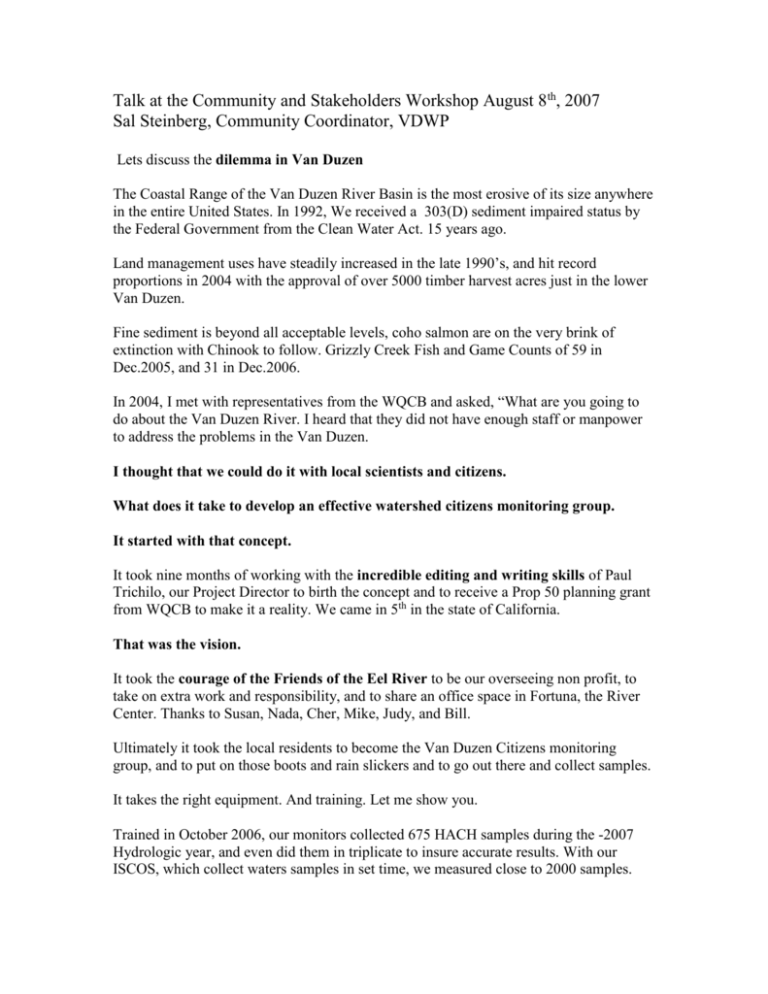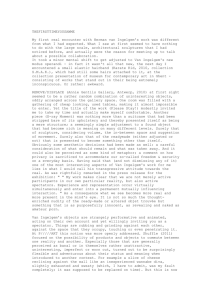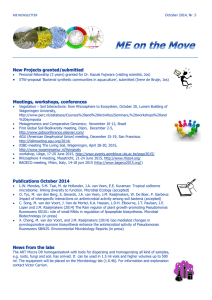What are the major problems facing the Van Duzen River Basin
advertisement

Talk at the Community and Stakeholders Workshop August 8th, 2007 Sal Steinberg, Community Coordinator, VDWP Lets discuss the dilemma in Van Duzen The Coastal Range of the Van Duzen River Basin is the most erosive of its size anywhere in the entire United States. In 1992, We received a 303(D) sediment impaired status by the Federal Government from the Clean Water Act. 15 years ago. Land management uses have steadily increased in the late 1990’s, and hit record proportions in 2004 with the approval of over 5000 timber harvest acres just in the lower Van Duzen. Fine sediment is beyond all acceptable levels, coho salmon are on the very brink of extinction with Chinook to follow. Grizzly Creek Fish and Game Counts of 59 in Dec.2005, and 31 in Dec.2006. In 2004, I met with representatives from the WQCB and asked, “What are you going to do about the Van Duzen River. I heard that they did not have enough staff or manpower to address the problems in the Van Duzen. I thought that we could do it with local scientists and citizens. What does it take to develop an effective watershed citizens monitoring group. It started with that concept. It took nine months of working with the incredible editing and writing skills of Paul Trichilo, our Project Director to birth the concept and to receive a Prop 50 planning grant from WQCB to make it a reality. We came in 5th in the state of California. That was the vision. It took the courage of the Friends of the Eel River to be our overseeing non profit, to take on extra work and responsibility, and to share an office space in Fortuna, the River Center. Thanks to Susan, Nada, Cher, Mike, Judy, and Bill. Ultimately it took the local residents to become the Van Duzen Citizens monitoring group, and to put on those boots and rain slickers and to go out there and collect samples. It takes the right equipment. And training. Let me show you. Trained in October 2006, our monitors collected 675 HACH samples during the -2007 Hydrologic year, and even did them in triplicate to insure accurate results. With our ISCOS, which collect waters samples in set time, we measured close to 2000 samples. It takes the creativity of Dave Slyter, who designed the Slyter stick to take triplicates in tricky places, to insure the safety of our members, and to combine stop watches, note pads, orange peel containers, and even bottle holders with rubber fish so as to not scratch the Hach Cells. It takes the scientific curiosity of the Jorgensons to continue to explore their beloved Cummings Creek, and to make it a better place. Their creek has been the site of numerous investigations over the past decade. Macroinvertebrate studies with their children, monitoring and restoration with EERWIG. (Eel River Watershed Improvement Group) It takes the dedication of Maria who sampled on 126 separate occasions in one year, our record. It takes the long-range commitment of Barry Stewart, on Fox Creek, who for several years has taken samples and pictures for Friends of the Van Duzen and who purchased his own turbidimeter years ago so that he could know what is happening in his local habitat. It takes the sense of community responsibility of the Weare family, who with the Eel River Improvement Group rocked their Main stem Van Duzen river bank with 12 feet of boulders to protect them from floods, and are living the vision of Bill Weare to be on the river and protect and preserve it. Bill took 101 samples in 2006-2007. What does it take to make a community group? It takes the desire for the return of the salmon, and the steelhead by Jim Johnson, of Flanagan Creek, the cumulation of his fisherman tales, and his will to see the river viable with fish in his lifetime. What does it take? It takes cooperation with agency folks like Steve Cannata, Chris Ramsey from the California Dept of Fish and Game. Both have been invaluable to the process of studying the river and offering their scientific and educational expertise. Expertise - Or fellow Fish and Game, and private consultant, Van Duzen musician and geologist, Dave Heaton, the one who knows more about the rocks and hills in the Van Duzen than any other man on Highway 36, and who provides a steady presence with his cross sections, and creativity with his musical production skills for the video you are about to see. Recruitment : Recently we found Isaac Mickels, a very bright young man with a family on the Van Duzen, who worked with Paul on habitat typing. We are always in an active recruiting mode. There is a volunteer sign up sheet on the table. We would love to have your help! What does it take? It takes a sense of community embodied by the Mullan family. Paul Mullan is our youngest monitor working Wilson Creek,who did an excellent science project, and learning about his world. When we recruited him for Wilson Creek, he showed me the culvert that he used to play in as a boy. Mike has been very helpful with matching funds for the project, his rain measurements, and Virginia always goes the extra mile for her own kids and school kids organized field trips to the stream. Speaking of rain. It takes communication. How about Sister Marge, the Weather girl, retired Junior College professor, Union boss, and world traveler, and Carlotta resident who sent us messages regarding all the 2006-2007 storm events in the Van Duzen with commentary. We got one message from England. It’s about education. Thanks to Kristina Darby, Scotia Scientists in the Schools Gate Science Coordinator who helps plan these school outings, and to organize me. To Pal Halstead whose Fortuna Creeks Project is a model to the nation and provides students to act as Mentors. Special thanks to Superintendent Collver who has worked closely with us on the educational field trips, and who provided the space tonight. And Blaine Sigler from Cuddeback. High Standards : Thanks to Ed Brenneman, one of my best buddies and golf partner, who drove the accuracy of the 1st year monitoring project by insisting that all samples be measured for turbidity within 48 hours of coming from the stream. That will get you going. How many late nights did he spend cleaning bottles and labeling to provide us with bottles for the next rain storm. High performance: Humboldt State University. Dr.Kristine Brenneman, who has worked with our projects for the past five years and provided us with a continual stream of grad students from her Waste Water Management Lab. She continues to raise the bar for us and demand excellence in our approaches. Field Smarts: Is there anybody better in the field than Jesse Noell. Jesse blends into a stream like the creatures who live there, and adds the human knowledge to the pool of intelligent nature. Jesse runs our more intensive stations, and provides technical assistance to the project. Or to the artistic and visionary works of Mike Guerrero and Dona Blakely, and their continual support of our endeavors in unwritten ways. Steadiness. Steady as she goes. And sometimes the river rages. I had the pleasure of going to the sites with Karen Bromley, HSU graduate student who is doing her masters on the Van Duzen, and who approaches water quality monitoring with a workmanlike quality. Guidance. Where would we be without Clark Fenton of Salmon Forever. His continual presence, his expertise, his availability, his laboratory, his strong will and sense of justice and scientific correctness has propelled this project to wherever it is now and where it will go in the future. Many thanks. Thanks to Sarah for helping to organize the suspended sediment data from Clark’s lab. Knowledge. Randy Klein. We are so lucky to have Randy. For those of you who know of the work of Dr.Kelsey, Randy is the Kelsey of this time, and has dedicated his life’s work to the study of river systems and the improvement of our natural world. He’s our other guide to the future. Macroinvertebrates – indicators of the health of our streams. Over the years we have worked with Nic Simpson, HSU, and now we have the honor to work with Jon Lee, highly respected aquatic biologist, who works with local tribes and non profits. Thanks to the Wolverton Creek Group. Claude and Berta Young are landowners who have made their stream available for over a decade to study by agencies, Friends of the Van Duzen, school kids, and to participate restoration projects. Now we have on board as consultants Eric Nelson and Bill Shapiro, so we can have more presence on Wolverton to find out why the creek no longer is supporting salmon and steelhead. I worked with Jim Rizza, a former science teacher from Hydesville, who made the connections to Claude, and who in his retirement maintains his connection to Van Duzen Basin by sampling several of our streams. Thanks for your continual support of the scientific world and your dedication to the Basin. Jim’s been monitoring Wolverton and Yager. What does it take to monitor a river system? Our rangers have been great at Grizzly Creek and Hely Creek. Robert Leiterman and Pat Boyle are stewards of our most valuable places in the Basin and deserve kudos for their years of service to the Van Duzen. Pat is an active monitoring person. Dana Johnston assisted us at the beginning of this project. How do we get this information out to the public. If you’ve never gone to the Friends of the Van Duzen Website, www.fovd.org you should check it out. Tom Travis has been affiliated with FOVD for the past five years and is now designing the Van Duzen Watershed Project section with input from Doug Renwick, a long standing computer mind, who is using new technology of Google to help to show our monitoring sites. Barbara Domanchuk lives on and loves the Van Duzen River Basin. She’s been involved with Friends of the Van Duzen in numerous projects, and we’ll be showing her current video about the project and the citizens monitoring group in a few minutes. Every minute of video demands concentration, planning, and vision. We’ve added a 2nd videographer for our public events. Thanks to Ron Nelson, independent photographer. We are a Watershed Planning Grant. We collect data and analyze for two years before writing a report with our recommendations for the reduction of sediment and the beneficial uses of water. You’ll hear and see the term Total Maximum Daily Load TMDL which is a “numerical calculation that identifies the maximum quantity of a given pollutant ( in this case sediment) that can be discharged on daily basis, while still permitting that water body to meet water quality standards. For more information Read A Primer on Total Maximum Daily Loads in the brown Eel River Report and our article The Van Duzen Watershed Plan in the yellow Eel River Report. Pat Higgins will be adding his expertise to this mix during the planning process. We are now a three-year grant with the mission to conduct water quality studies for two years and to develop a Van Duzen Watershed Plan to reduce sediment in the Basin and improve the beneficial uses of water. So, it takes courage, commitment, and conviction to pull this off. Not to mention hard work and a good set of boots and rain slicker. It takes a community. Thanks to my wife, Naomi, for giving me the freedom to pursue my river passions, share our belief in sustainables systems, and live and swim with me in the wild and scenic Van Duzen River. So lets roll the video. Music by Bill Weare and Steve Cannata. Production by Dave Heaton.







